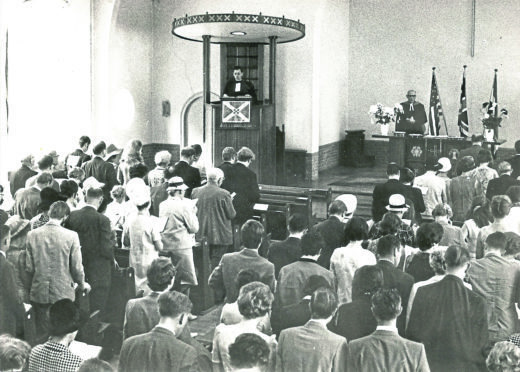It has survived as a Scottish place of worship in the Netherlands since the 17th Century.
The kirk congregation even carried on undaunted after the Nazis destroyed the building during the Second World War.
And now the Scots International Church in Rotterdam, which was founded in 1643, will mark its 375th anniversary with a string of events culminating in a special service on Sunday.
The Moderator of the General Assembly of the Church of Scotland, the Rt Rev Susan Brown, minister at Dornoch Cathedral in the Highlands, will preach at the event.
And she spoke of how the multinational congregation reflected the inclusive attitude of the myriad Scots who have journeyed abroad to spread the gospel since the days of Shakespeare and Queen Elizabeth 1.
Rt Rev Brown said: “It is a congregation which, over the years, has continually reviewed and renewed its role and vision and as such offers vibrant testimony to the faith that undergirds all it does.
“May they continue to be a blessing to all who walk in through their doors – people of all nationalities!”
That message was echoed by Reverend Derek Lawson, who has been based at the church since choosing to come out of retirement in 2016.
He said yesterday: “We are celebrating the past, but we are also looking to the future.
“On Sunday morning, I look out on a congregation of around 30 nationalities.
“We have changed dramatically.
“Originally, we were primarily Scottish, but today we are about 30% British, 30% Dutch.
“Historically, we have had a lot of Americans and Canadians, but we now also have people from Asia and Africa.
“The English Language is the common denominator, though it may be their second, third or even fourth language.”
Mr Lawson believes the Scottish presence in the city was primarily due to the large number of sailors, soldiers, merchants and dyke-builders who travelled across Europe during the 17th century.
Foundation stones were brought all the way from Scotland in 1695 to construct the first church building and this remained in use until 1940 when the shrine faced its biggest threat.
Mr Lawson added: “There was virtually no contact with Scotland during the Second World War.
“After a bomb destroyed the building in 1940, there was a real risk that it would not continue.”
However, through the efforts of the congregation, and with financial support from Rotterdam merchants, the then Moderator Rt Rev Johnstone Jeffrey visited the church to dedicate a new building in 1952.
Rev John Russell, who is the Presbytery Clerk of Dunkeld and Meigle, was minister of the Scots International Kirk from 1963 to 1972 and will also attend the anniversary service.
He said: “My wife and I loved our time there. The manse was our first home as we arrived on a cold winter’s night to a warm welcome 13 days after marriage.
“When I was appointed in 1963, I was given the task of reaching out to the large English-speaking population drawn from Britain, the Commonwealth and the United States and many other nationalities living throughout South Holland.
“In my ministry this outreach was carried out and the congregation became truly multinational, a tradition that has continued throughout successive ministries.
“We are very pleased to be going back. It is very kind of the church to invite us.
“One of our sons who was born in the manse is coming back too.”
The strong connection to Perthshire goes all the way back to the 17th century as the first minister Alexander Petrie came from Rhynd, serving from 1643 to 1662.










